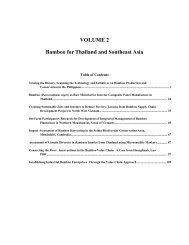WBC-VIII-Vol.4 – Resources – Forestry, Plantations and ... - BambuSC
WBC-VIII-Vol.4 – Resources – Forestry, Plantations and ... - BambuSC
WBC-VIII-Vol.4 – Resources – Forestry, Plantations and ... - BambuSC
You also want an ePaper? Increase the reach of your titles
YUMPU automatically turns print PDFs into web optimized ePapers that Google loves.
showed higher coefficient of determination (R 2 ), low root mean square error (RMSE) <strong>and</strong> low bias were<br />
considered to be preferred. Analyses were performed using the PROC REG procedure of the SAS/STAT®<br />
statistical programme (SAS INSTITUTE 1999).<br />
Models for predicting culm length, basal area <strong>and</strong> culm hardness, showed the better performance. However, the<br />
variability in the productivity <strong>and</strong> quality of guadua could not be entirely described by the variables measured<br />
<strong>and</strong> a significant proportion of the variability remains unexplained. The best for growth variables was for culm<br />
length which includes 11 variables <strong>and</strong> explains 54% of total variation (R 2 = 0.54, RMSE = 2.3). Most of the<br />
variables contained in the model were related to soil properties (especially physical soil properties), however the<br />
temperature was the most important independent variable. Residuals analyses did not show any special trend <strong>and</strong><br />
for all of the classes <strong>and</strong> the residual variation must be interpreted as r<strong>and</strong>om (Figure 3).<br />
Residuals (m)<br />
6<br />
4<br />
2<br />
0<br />
14 16 18 20 22 24 26 28 30<br />
-2<br />
-4<br />
-6<br />
Average h predicted (m)<br />
Figure 3. Plot of residuals versus predicted values of average culm length (h).<br />
For st<strong>and</strong> variables the regression model for basal area gave the more reasonable goodness of fit (R 2 = 0.51,<br />
RMSE = 20.3). It means that 51% of total variation was explicated by the model. Five of the eight variables<br />
included in the model are soil properties <strong>and</strong> the most relevant was apparent density. The residuals analysis did<br />
not show any systematic bias when plotted against predicted values (Figure 4).<br />
<strong>VIII</strong> World Bamboo Congress Proceedings Vol 4-40




